Being immersed in the fitness industry provides me with a ton of different opportunities to experience different techniques, methodologies, and products. I recently had the privilege of a...


Being immersed in the fitness industry provides me with a ton of different opportunities to experience different techniques, methodologies, and products. I recently had the privilege of a...
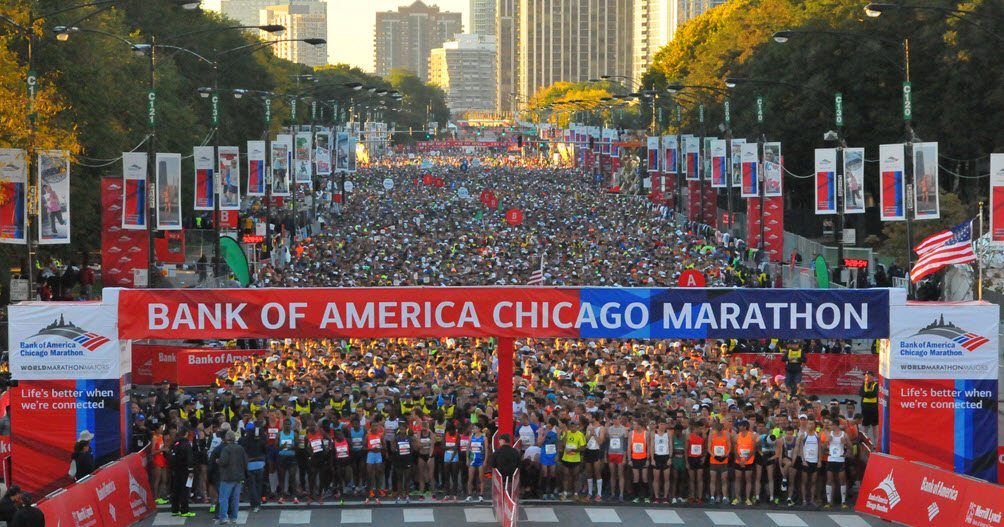
Leading up to the Chicago Marathon 2016 The Chicago Marathon provides an excellent course, plenty of support and, for me, a chance to visit home for a few days. It was no different for me this...

September 25 was going to be my day. The Ironman Augusta 70.3 triathlon was finally here. The race I had been training so hard for on one of my favorite courses. It was four-and-a-half months...
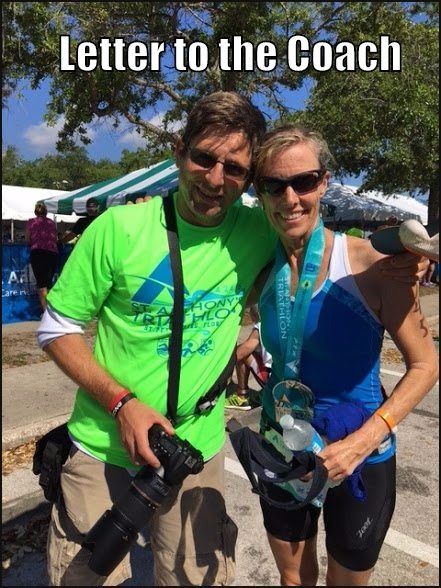
I have been an endurance coach for some time now. Once in a while, I receive an email from a client which chokes me up with pride. Today, I received one of those letters, so instead of sharing it...
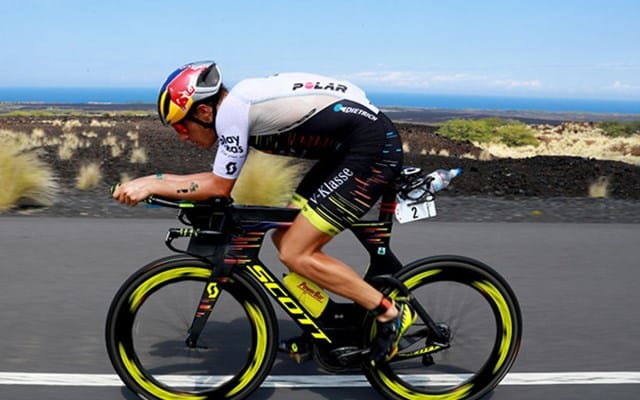
I found when looking for ways to get faster on the bike, is that there is so much information, from different coaches and experts, that it can be confusing and overwhelming. Personally, I...
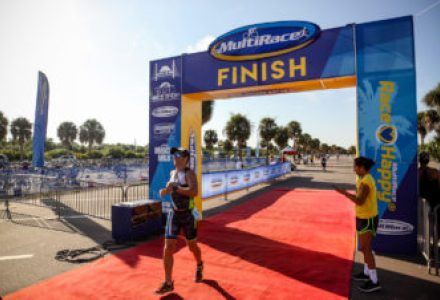
The previous post was a review of the FD3 Triathlon Series as if it was a product. Below you will find a more detailed account of my personal experiences during the race. Let me know in the...
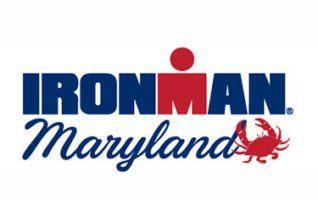
I signed up for Ironman Maryland initially due to the reviews that said it was fast, and beautiful. Jaime started it with all the hype about it being a fast flat bike course because she despises hills, even though most of her fastest bike splits came on hilly courses. Touché. So, last year after a lot of pestering Pete, we registered and the training began. Pete, Jaime and I have been training together for about 4 years, ever since I decided to get serious about triathlon. We ingeniously started calling ourselves “PB&J”. Get it? Peanut Butter and Jelly or Pete, Brad & Jaime.
Interesting enough though, I really wanted a sub 12-hour Ironman and Jaime was shooting for a sub-13, so as much as we enjoy training together we actually ended up going our own ways. I started training at Tribal Multisport with Coach Jon Noland, and Jaime trained with Personal trainer and elite athlete Kenneth Jones.
We made all the arrangements well in advance. We had hotel reservations at the host hotel, restaurant reservations, tri-bike transport was scheduled, flights were booked and cars were rented well in advance.
We talked constantly throughout the months, confirming our plans, comparing training schedules and every once in a while, we actually did get together to train. PB&J looked strong and ready to face IRONMAN Maryland together. Unfortunately, in September, Pete ended up injuring his Achilles’ tendon and after a lot of conjecture decided it wasn’t in the cards for him this year. I told him, it would better to live and race another day than to permanently hurt himself.
We departed for the race on Wednesday, September 30 completely anxious and excited. We headed to Tampa International Airport, for an uneventful flight into Baltimore-Washington Airport. Within a half hour we were in our Jeep Compass rental and headed up Rte 50 in Maryland.
We stopped for a quick lunch at Carmine’s Pizza to carb load with pizza and salad and just as we are about to pull out of our parking space and back into traffic, Jamie’s phone rings. Ed, a friend and first time Ironman athlete, called and tells us the race has been cancelled. I could hear Jamie’s voice say, “Uh say that again…wait…wait. Let me put you on speaker.” A deep Jersey accent comes from her speaker and says “They cancelled the race.” Really? This early.
The last time WTC cancelled a race it was in Lake Tahoe and the athletes were in their wetsuits ready to jump in. They waited that long and now, 3 days before the race they were cancelling it.
We jumped on Facebook, and the IRONMAN Maryland site and were met with the validation that WTC had indeed cancelled the race. It turned out the immediate threat from Hurricane Joaquin was dire and it was in their best interest to keep the athletes, volunteers, race staff and spectators safe. Not to mention, there was already four inches of water already on the course.
We got somewhat lucky. We were able to find a flight home that night, and the hotel did not charge us a night for cancelling so late. Unfortunately, the flight back cost us just as much as the full round trip, and because we pre-paid the car we couldn’t get that back.
WTC anticipated rescheduling but couldn’t give the athletes a final decision until the following Tuesday. The wait was hard. What do you do? Do you keep tapering? Do call it a season? There was nothing to do but wait.
Late Monday night an email hit my account stating that the race was back on and it would be held on October 17th as predicted. All I can think of was “Here we go again.” What if the weather was bad again? Would we spend even more money just to go through another disappointment?
Coach Jon, put a schedule together of low duration, high intensity workouts to keep my body from degrading fitness for the next week, and I managed to squeeze out a 17 mile run with a client that felt awesome the Sunday prior. The weather outlook was good, cold, but decent. As the days passed, the forecast kept getting colder and windier, but no precipitation was even close.
This time it was going to happen.
From Tuesday on, Jamie, myself and another training partner of hers, Hunter, had a group text as we kept planning our trip. We found decent round-trip flights, Hunter found a rental house, and I again reserved a car. Of course this time I bought the trip insurance as well, which, of course, I did not need.

The View from our DC Hotel
And on October 14th, we took off for the second time from Tampa and arrived, this time at National Airport in DC. We spent a great night at the Residence Inn in Pentagon City before heading out to Cambridge the next day.
As I drove though the rural part of Cambridge and into the long drive way of our rental home, I was surprisingly calm. Subconsciously, I think I just didn’t want to get my hopes up, but my heart rate did jump at the surprise I felt pulling into the gravel drive way. It was gorgeous!

Our Cambridge Ironman HQ
There stood a modest one-story ranch home, but on a huge amount of acreage that backed up to a lake. It had it’s own dock, fire pit, pool, and a beautiful deck. Inside it was an open floor plan with a dining-kitchen area, huge great room and three good size bedrooms. It was decorated modestly, with wood floors and a kind of rural, yet updated and upscale charm to it. All of the appliances were current models in the kitchen and baths with flat screens in each room, and a large one, in the great room, a fireplace and gigantic sectional couch that all of us could have slept on.
What was even luckier was that it wasn’t only Hunter, Jamie and myself, but Kenneth and his parents, so by sharing it, the cost was not even half of what we would have to pay for the hotel.
I also have to say, that Ken’s parents, treated all of us like we were their kids. His Mom, Lucy, cooked and cleaned for us, and his Dad, Phil, grilled, shopped and chauffeured us around to make sure we were at the right place at the right time. It was like Ken, outsourced his parents to us. Of course that wasn’t the case. It seemed like they genuinely loved doing it.
It came time to travel over to transition and pick up our bikes, and then head to Ironman Village to check-in.
We reached transition and since Hunter and Ken already had their bikes, because Ken and his parents drove them up, they headed out to check out the swim start while Jamie and I talked to Tri-bike transport. Jamie’s bike was already in the rack, but unfortunately, mine was not to be found. My stomach took a little turn when Drew, from TBT, said I wasn’t on the list to have my bike at the race.
Luckily, he said that my bike was in the truck, but it was with the bikes that were sectioned off for the athletes that were not going to be returning.
I headed over to the transition area to scope it out and then took a quick peek at the swim start and at that point, my anxiety started to increase. This was happening. There no “ands”, “ifs or “buts”. I was going to be racing my third Ironman.

Ironman village was exactly as it was for every other Ironman and Ironman 70.3 I have raced except, because they were not able to keep all of the original volunteers procured, it was a lot slower checking in. We waited in line for close to two hours before we finally made it under the tent to pick up our packets and swag.
When we finally got through that line, we contemplated going into the Ironman store, but the line to check-out was just as long and we still wanted to get a quick workout in. In every Ironman store I have been in, for every race, the cashiers, (bless their hearts) are always so slow that you know if you do get in that line, it is going to be a lot of time.

We headed back, and unfortunately, I had yet to receive a call from Drew to tell me that he was able to dig out my bike, so the others headed out on their bikes and I decided I would just work a little while I waited for his call. At 4pm, I did receive the call and 45 minutes later I was back at the house with my bike.
Leading up to the Saturday morning, was pretty much the same as any other long race. Putting gear bags together, going over transition and nutrition plans, and quick workouts in all three events. These were basically just to make sure everything was in working order.

The Goof, Ken, Hunter, Jaime & Ed before a swim workout
Did I mention Thursday night we had a campfire and made s’mores? Yeah, we did that too.
I was pretty shocked at how well I slept Friday night. We had all turned in quite early, in anticipation of not being able to sleep, but I drifted off pretty fast and slept until the 4:00am alarm woke me up. None of us were in a rush as we all felt pretty prepared, and the outside temperature was only in the upper 30s. I dressed, ate and leisurely grabbed my morning bag and we headed out into the darkness.
Leaving the house I had yet to really feel nervous, but as soon as we pulled up to transition, I felt a pressure in my chest. My heart started to beat so hard, I thought it was going to crack through my rib cage and take off on me.
I looked over at Jamie, and she looked back and said,”Sh*t just got real.”
After outfitting my bike with my nutrition and helmet, I took a walk over to the actual swim start line and looked over the water. Waves didn’t seem that bad, but the water was far from calm. I could feel the wind on my skin even through the wetsuit. Luckily, while it was 38 degrees outside, but the water it was 63. That was going to work in our favor, as it was actually going to feel warmer in the water.
Around 6:40, Jamie, Hunter, Ed and I were all hanging out trying to keep warm and maintain a positive mental attitude, when the speaker echoed our announcer’s voice. The safety team had stated that the winds were causing a lot of churning in the water, so the boats and paddle boards could not take their places on the course. The solution was to shorten the course to 1.2 miles.
I should have been really excited about this, as the swim is my weakest event, but I wasn’t. I was actually a little upset not only because I wanted to prove to myself I could get out of the water within my goal, but also for Ed and Hunter as this was their first full distance Ironman.
What else could happen? First they postpone the race, and now they shorten the course. This race just seemed cursed.
That was not the end of the story. Around 7:10, an announcement was made that, the winds had died just a little and would be enough to get most of the swim in. We would do the swim, but we would be about 800 meters short.
Things just looked better. I felt redeemed and a positive relief flowed through me for about half a second. I still had to get passed the swim. If you remember from my post about my last Ironman, I was the last one out of the water to be able to cross the line. I worked a lot harder on my swim this training cycle, now I would have to prove it.
At 7:30 we lined up according to how much time we thought it would take us to swim the full 2.4 miles. I lined up at the behind the 1:30 sign and after waiting another 20 minutes to get through the line, it was my turn to jump in.
The water still frigid enough to shock my body a little, but my adrenaline kept me warm. I immediately headed to the first buoy where we would turn right and then head in triangular pattern.
I felt really good during the first lap. For the first time in an Ironman race I was actually passing people and it felt amazing. I still felt pretty strong as I made the turn for the second lap, but I did slow down a bit.
As much as I thought I loved my long sleeve wet suit, I didn’t have the mobility in my arms, that I developed during training, and I had to strain to lift my arm into a streamline position. I listened to myself hypothesize about it and I thought, “Am I really thinking this? Did I really become a decent enough swimmer to even contemplate it?”
On the second lap, the wind picked up again and I thought I was swimming in my washing machine. I got tossed around and the effort level increased. I did end up breast stroking intermittently for a few minutes to catch my breath and realign my siting, but I continued. My habit of zig zagging didn’t show up until the last straight away while I was trying to sight on the finish. The waves were pushing me in the wrong direction, but my sighting was able to put me back on a good path. I jumped out of the water and ran towards the timing mats, and as I crossed I looked down at my watch – 1:10.
1:10? Really? I had to double check it twice. If I added the 800 meters back on I would have finished around 1:25-1:30 which, was my goal.
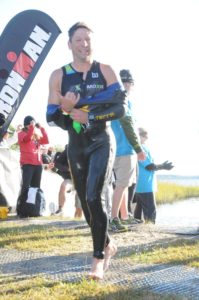
I was so excited I sprinted to the strippers, but for some reason they didn’t help. My wet suit would just not come off of me and when it did, oh man, did I feel the weather. The wind hit me, and my soaked tri kit, like a brick wall.
I headed into the changing tent and dawned a bike kit, arm warmers, a gator neck, and gloves. By the time I added my helmet I looked like a Tri Ninja.

Ed gave us a quick rundown of the bike course the night before, as he came up earlier in the year and actually trained on it. He explained how the course was an oval and we would probably have a head wind on one of the shorter sides and away or back to transition. This would account for two blocks of 12 miles since we had two laps. I was ok with it. I would just turtle for those 24 miles. (This is a technique keeping your head down and allowing your back to come up like a turtle shell to be as aerodynamic as possible.) The rest of it my plan was to stick to 75-80% of my functional threshold power(FTP) as possible. In training that proved to be right around 20 miles per hour which should get me back to transition in 5:35, and then taking account for the wind, sub 6 hours.
No such luck. I have never ever been on a bike course where the majority of the turns were to the right, and kept being hit by the shear force of a 33 mph head wind.
I wish that were the only factor that slowed me down.
I knew because of the temperature that I would not want to drink, but due to the fact my calories were mostly in my bottles, I would have to. What I didn’t count on was that I would have to stop at a portlet every 10-15 miles to urinate. I am just not die-hard enough to urinate while I am on the bike, and we were specifically told that if athletes were caught relieving ourselves outside of designated facilities they would be DQed. That slowed me down.
From mile 40 to 50 we were all riding on the shoulder of the road, into the wind. Directly to the right of the white line were slowing rickets with very small spaces in between them. They seemed a little dangerous, so everyone was either on the right of them, or on the left and swerving to the right when traffic would come from behind.
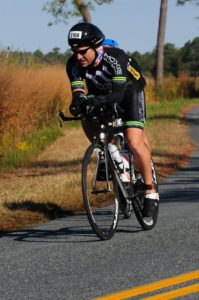
I was in aero, with my head down, when I saw a tire in front of me, so I yelled “On your left.” The wind was so loud the person in front of me, wearing a “This Guy Needs A Beer” jersey, could not hear me. As I slowed down to keep enough bike lengths between us to satisfy the drafting rule, I noticed a motorcycle next to me. It was an official.
He pulls out a memo pad and yells to me, “At the next penalty box, tell them you have blue card.” Well, I wasn’t going to start arguing while I was the bike, so I nodded.
At the mile 56 aid station there was a penalty box, so like a good athlete I did what I was told, and so did the other seven athletes that came in behind me. There we all were. Eight, age group, athletes standing stretching while we waited for our five minutes to be up. I am all for rules, order and safety , but it’s a little ridiculous when there are eight people in the penalty box all caught doing the same thing on the same stretch of road. As this was my 3.4 hour mark on the bike, I asked the volunteer who had to time the penalties how many he had so far. He kind of smirked and said it had to be over one hundred.
At that point I just had to laugh. I got back on my bike and continued trudging through the wind.
Ten miles later, a slow burn started aching my legs. I didn’t understand it. My cadence was up, but no matter how high I shifted, I felt like my effort level was increasing. Then I heard what was a metal grinding. Yep, you guessed it. A flat in my rear tire. These were brand new tubular tires, I had installed just for the race, and now I punctured them. I had a bottle of pit stop in my jersey, so it was only a couple of minutes before I was back on my bike. With Pit Stop, I didn’t even have to take the tire off, just empty the contents of the bottle into the tire and go.
Luckily, I didn’t have to stop nearly as much the second loop as I did the first to urinate, so I picked up a little bit of time, but while keeping to my FTP goals, I could barely get above 17 mph. It felt slow and torturous.
The left turn for the last 12 miles came and I thought maybe we would catch a break and as I passed the last aid station one of the volunteers yelled, “Your on your way back, no more wind!”
He lied.
The whole way back to transition, the wind hit us and kept our pace to a slow 16-17 mph.

As I dismounted my bike, I could feel not feel my toes or my hands, and I was just frigid. I tried to take off my bike gear, and it was extremely difficult. I felt like I did, during the last ironman at mile 13 of the run and I hadn’t even started the run yet.
The grumbles in the changing tent were all the same. The bike was windy, it was tough and it sucked, but it was over. A few of the guys who competed in last year’s event said they were over an hour slower than the previous year. That actually made me feel a little better.
I have a saying I give to my athletes when they start to walk or I find them giving up on themselves. “The mind will quit 100 times before the body does.”
For a nanosecond a thought went through my head. “I already did two of these, I don’t need to prove anything to anybody. Forget this.” Then the next nanosecond went by with my inner dialogue that said “Who are you kidding Minus? You know you are going to finish if you have to crawl across that finish line. You never quit anything in your life, what makes you think your going to do it now?” The last words that echoed in my voice were that of my coach Jon Noland. “Embrace the Suck.”
I changed the best I could with numb fingers and toes and started the run. (I found out later I spent over 20 minutes in T2. It sure didn’t feel that long. I must have taken a nap.)
The first two miles felt a little slow, then at mile three it was like the pearly gates opened up. My legs transitioned into a good running form and I took off. I felt amazing.
I kept to my strategy of walking through the water stops, which during an Ironman is every mile, but they are only a few yards long, unlike those at a major marathon, where the distance could exceed a hundred yards.
At mile seven I actually felt a side stitch which hasn’t happened in a race in years. Luckily, I still had my wits about me. What is the cause, or better yet, what is absent from my body that would possibly cause a stitch? Potassium. Wouldn’t you know it but an aid station was just fifty meters ahead of me, so I grabbed a banana. Within the next quarter mile, the stitch was gone, so I picked up speed again.
The course was two-and-a-half loops that took us from transition through a residential neighborhood, around a park, back through the neighborhood passed transition, into downtown Cambridge where it either started again, or headed to Ironman Village and Finish line.
We had been told that Cambridge was supportive of the race and even in these cold temperatures, the town was out in droves.
Along the route there were kids on their lawns cheering, a dancing banana, residents on lawn chairs, and local bands playing outside their homes. While running through downtown people were outside the bars drinking and cheering every athlete on as they passed. It was just spectacular.
I found Jamie ahead of me around mile 5 and we ended up passing each other three more times. Each time I was getting closer and closer to her. I had hoped to get closer, but in the end she did end up crossing about three minutes ahead of me.
I never ran over 90% of the run during an Ironman before. This time the only time I walked was through water stops and only stopped twice to use the portlet. Granted it was not extremely fast, but it was still over twenty minutes faster than my best Ironman.
My legs at mile twenty were very heavy and this was the half lap and the last time I would have to turn left after downtown Cambridge. I kept going, and didn’t stop but it was getting quite dark to a point where there was a portion of road where I couldn’t see my hand in front of my face. I just kept going.
The thing I just kept thinking in my head was one day, I would finish an Ironman and it would still be daylight.
I came out of downtown Cambridge and made the right towards the chute. I heard the announcer call my name and as I saw the arch of the finish, I wondered if I had it in me.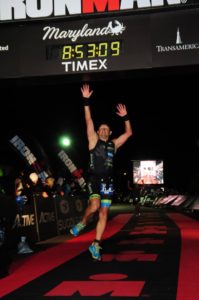
I ran just a little faster and jumped up, caught a little air and touched the arch. I was an Ironman. Again.
My finishing time was 13:08:53 which was actually and hour and forty-six minutes faster than my best Ironman, but if I kept the same pace on the swim, I calculated I would probably have crossed about 20 minutes later which would have given me a ninety minute personal record. In those conditions, I‘ll take it.
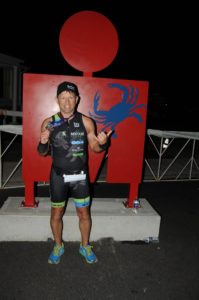
Of course I did not do this alone. I have to thank my coach, Jon Noland for training me (coaches need coaches too), the athletes at Tribal Multisport for pushing me further than I thought possible, the Moxie Multisport team for the help with gear, nutrition, and the support to keep me going through the long training period, my travel and housemates, Jamie, Hunter, and Ken for the great time at the house, and for keeping me sane and laughing, Ken’s parents, Phil & Lucy for the race weekend support, and last but never least, Kim for supporting me at home through this third Ironman.

It has been a while, and I have a ton of ideas that I am anxiously awaiting to share with you. Unfortunately, time has been getting away from me. Between training myself, a full-time job and being at capacity with 15 individual clients I am struggling for time to post. I promise I will figure out a way to make time. I am so lucky to have such great people to bounce ideas off of, that sometimes, by not posting, I feel like I am letting all of you down, so I promise to post more even if the posts end up being a lot shorter than usual. (Which the length is probably not your favorite part of it anyway. I know I ramble.)
Before I get into the nitty-gritty of my personal opinion of compression, a disclaimer.
I am not a medical professional. The opinions that are shared on this post come from research, my own experiences and the experiences of athletes I have personally witnessed and information I have researched. Every athlete/person has a different body and some products and/or methodologies may be advantageous for some and may even be dangerous for others. This post deals with my beliefs and my research. (Was that clear?)
Lately, most of the questions from other athletes, including clients of mine, have asked about compression. This usually centers around calf sleeves, but does include some of the other compression apparel as well. My answer is usually, for recovery and for temporary use they are great, but not for training. Why? Great question.
I am going to use calf sleeves as my example.

While running, biking, swimming or any major activity using the legs, the muscles are constantly in motion. That motion is what naturally makes the muscles stronger. The muscle moves and is loaded with either more repetitions, or with weight. The full range of motion of each muscle is imperative to the strengthening of the muscle. Compression holds that muscle in place and limits the movement therefore limiting the range of motion. While compressed the muscle cannot fully develop while training. Let’s take a look at the anatomy of the lower leg in the running position.


As you can see the gastrocnemius muscle and Achilles tendon, when the knee is flexed, both constrict and then elongate when the knee straightens. Here is the epitome of the range of motion naturally occurring when running. The more flexion and constriction that take place the more they are stretched causing the breakdown of the fibers. After the recovery period the fibers wrap tighter and in more abundance aiding in a strength and endurance. Now imagine that gastrocnemius muscle remaining constricted due to a calf sleeve. It seems to me that this would dictate that it would not have full range of motion also causing the Achilles tendon to remain stretched without the full ability to absorb the impact. This could unintentionally damage the Achilles tendon, the gastronemius muscle and the soleus muscle. If not damage, it will limit the ability to be strengthened. This is why I personally do not recommend calf sleeves during training workouts.
Recovery
I do however do not mind wearing compression while in recovery to include immediately following the cool down of a workout. I mentioned the healing of the fibers earlier. In order for the fibers to heal and become stronger after the breakdown, blood must be pumped through the muscle and with it water for hydration. Compression does help to isolate that area helping to keep the majority of the blood and water being pumped through the body to the point of the compression. With the legs either elevated or even walking around and at that point limiting the movement, it would allow for the blood to pool in that area helping to re-hydrate the muscle thereby helping to heal faster. In turn, an occasional training run or race, with compression at the tail end of an injury, might also benefit, but in a very limited quantity, and duration.
–IronGoof
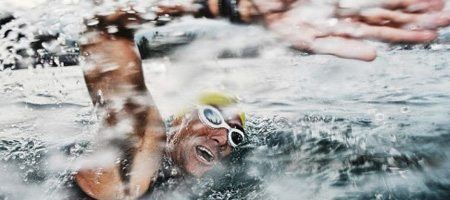
In my recent post, Effortless Swimming-Goof Out#1, I gave a summary of the introductory lesson in Effortless Swimming’s Mastering Freestyle Course. This course is located within the Swimprove program hosted by Brenton Ford and his Australian company Effortless Swimming. I continued with that lesson for a week which was dedicated to balance and streamlining within the water, and I recently continued with lessons 1 & 2.
Lesson 1 was specifically geared to the feel of rotating from your hips. I did this workout 3 times and I want to nickname it the Core Killer. I never thought working out in the pool with so little movement would cause such a tightness in my abs and core, but nevertheless, my abs, obliques, quads and hammies where a little tight the next day. It consisted of 1800 meters of drills, plus a warm-up and cool down making it 2400 meters total.
The Workout
WU: 300m any stroke
MS: 300m Kick on side w/ shoulder to chin
300m Kick on side w/ hand-to-face
300m Kick on side w/ switch
300m Kick on side w/ arms at side
300m Kick on side w/ arms across chest
300m Kick on side w/ blockhead arms
CD:300m Easy Free
I do not have a strong kick, so I continued to use my Zoomer fins to reduce my worry of propulsion since I knew that was not the focus of the workout. Lucky for me, Brenton actually suggests the use of fins in both the written material and the videos that accompany this course.
Throughout the workout, I noticed that when it was more difficult to rotate from my hips, I was not streamlined, however when I engaged just my core, and lengthened myself, rotating the hips became a lot smoother and I did move faster to the other end of the pool. I also learned more about breathing, because when you have one shoulder out of the water and you are look at the bottom of the pool, once in a while it is nice to turn your head and breathe. The breath is quick, so I started to breathe out during the drill and breathe in when I rotated. This was never natural for me and I know it caused a lot of anxiety for me. It still isn’t natural, but it makes a lot more sense. Once I finish the lessons, I will be able to develop a relaxing pattern with this new revelation.
Lesson 2 added the arms. I kept the fins with these drills, but because there were only three drills, I dropped them afterwards and swam one thousand meters without them. I was still slow, but I noticed it was quite a bit easier. I also developed a patter of breathing for myself, which I still am not consistent with but, when my position is streamlined and I am keeping a high elbow, it is a lot easier with the new breathing patter. It makes for an interesting alert. If I begin to feel like my breathing pattern is off, most likely it is because my swimming technique as fallen apart.
The Workout
WU: 300m any stroke
MS: 300m Shark Fin Drill with pause & return
300m Shark Fin Drill with practice entry
300m Shark Fin Drill with switch
10×100 Free Form Focus
CD: 300m Easy Free
This weekend will be the test. My first triathlon of the season is Sunday at the HITS Ocala Olympic Triathlon. I still have one more module of the Mastering Freestyle Course, but that will have to wait for next week. I am going to use my last workout this week to continue with the lesson 2 drills. We will see what happens. I am really excited
You can checkout the Swimprove program at www.swimprove.com
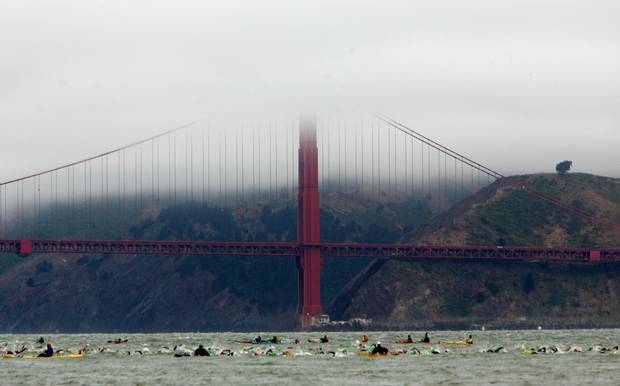
 triathlon. Deaths have been on the increase in triathlons and the vast majority of them occurring during the open water swim leg. This post is not intended to scare into never swimming in open water or ever competing in triathlons, but provide information about the precautions to prevent these types of accidents from occurring.
triathlon. Deaths have been on the increase in triathlons and the vast majority of them occurring during the open water swim leg. This post is not intended to scare into never swimming in open water or ever competing in triathlons, but provide information about the precautions to prevent these types of accidents from occurring. experience swimming in it to understand its somewhat constricting feel. Even a few laps in the pool helps.
experience swimming in it to understand its somewhat constricting feel. Even a few laps in the pool helps.
The title of the post is lending itself to a race report but I am going to step back a bit. Wednesday morning around 6 am my phone started to vibrate. Unfortunately, I missed it because I was in the pool, but after I finished my hygiene regimen, I grabbed my phone out of the locker and noticed it. I knew whom it was from and what it said before I even looked at.
Recently, Pete’s Mom, Noemi, has been dealing with a lot of complications from the brain tumor they operated on 23 years ago. Over the last few months she has been in-between hospitals and rehab centers with pneumonia and other lung related issues, and finally last week she was taken to hospice in Dade City. I made it a point to check-in on Pete, as often as possible and make a couple of trips to hang with him at the hospital or wherever just to give him and his family a sense of normalcy and support. Wednesday morning, around 5:12 am her suffering finally ended.
Pete is a red-blooded American male in every sense of the word. His does not show his emotions to just anyone, and even in his toughest times, he continues to care about other people. The interesting thing is his family is pretty much the same way. His Dad made it a point of finding me when I visited the Hospice Tuesday night to thank me. Even though I knew this man was in a lot of torment, he smiled and kissed me on the cheek. Pete’s Sisters are the same way. Not a tear, not a drop of contentment, just gratitude. This is what made this decision so hard.
The Best Damn Race was scheduled for Saturday, but the funeral for Noemi was on Friday and the viewing on Thursday. I promised to help set up for the race, but something like this was not in the cards when that promise was accepted. I really wanted to be there for my friend and his family, but I had no intention of disappointing Nick either. Thursday morning, I made the phone call everyone I know dreads; disappointing a friend. I called Pete and asked him how much of an ass he thought I would be if I missed the funeral. I would be at the viewing, but I thought I would be of more use at the setup. Without missing a breath, Pete told me to go set up the race and that if he had a choice, he would switch with me. The advantage of being in this lifestyle allows for all of us to understand what it means to both train and staff a race. The truth is; I would have said the exact same thing.
Friday morning I drove up to the Safety Harbor Marina and saw an open field with a few tents being set up, a huge Budweiser Truck and a few guys marking the areas for different structures. The day was filled with moving boxes, putting up tents and tables, running errands and just making sure Nick and the teams were supported.
Very quickly, the expo ramped up and was in full swing by noon. It was amazing, to watch. Not that I hadn’t seen it before, but I was never as close to it. This was an idea hatched a little less than a year ago and here it was. The finish chute went up, and the “Best Damn Race” Logo was everywhere and that is when it finally hit me. This was real. Nick had really made this happen. Toward the end of the day, there were over 3000 runners registered, which is completely unheard of for an inaugural race. Nick, the vendors, the interns, the volunteers, and race staff were all in fast forward mode trying to get everything accomplished on time which to watch was nothing short of amazing. It was like a well-oiled machine. When Lisa, Ben, Ray and I finally decided to end the day and get some dinner, I was completely exhausted but exhilarated at what the next day was going to bring us.

Nick and Beth holding the tape for the first finisher
I was so excited I ended with very little sleep that night, but I still had no problem getting up, showering, throwing on my running gear and getting out the door. I had a few tasks Nick gave me to take care of before I headed over to the registration tent thinking that I would check with the volunteer coordinator to see if there was anything else before I started warming up for the half-marathon. It turned out we were a few volunteers short, so I ended up going to finish line to help out after receiving a distress call from Beth. This is why I was there. Sure, I signed up for the Half-Marathon, but my first priority was to Nick and the race. I ended up spending the whole day, handing out medals, and supporting the runners, so as much as I wanted to run, I had an amazing day.
I watched and hung medals over the necks of a ton of my friends as they cross the finish line, I had the opportunity to hold the tape for a few of the elites, I handed out and hung over a thousand medals, and just felt privileged and honored to be a part of it.
Were there a few hiccups in the operation of the race? Of course, but Nick, and the race director Phil LeHaye resolved all of the issues seamlessly. A year ago, I have to admit, I had my doubts. I knew it could be done, but taking on this huge of a challenge and making it look as professional as it did, exceeded my expectations. I am so proud of my friend Nick Zivolich. What he was able to accomplish and all of the obstacles he overcame is nothing but inspiring.